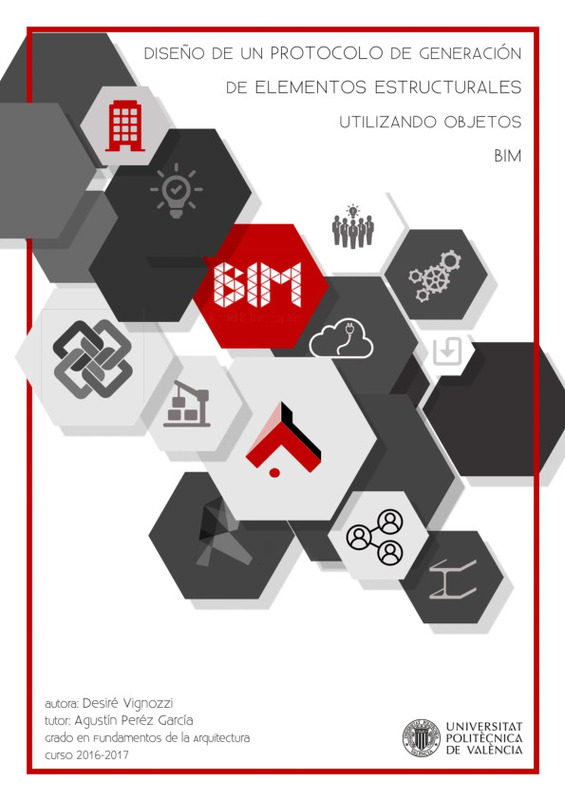JavaScript is disabled for your browser. Some features of this site may not work without it.
Buscar en RiuNet
Listar
Mi cuenta
Estadísticas
Ayuda RiuNet
Admin. UPV
Diseño de un protocolo de generación de elementos estructurales utilizando objetos BIM
Mostrar el registro sencillo del ítem
Ficheros en el ítem
| dc.contributor.advisor | Pérez García, Agustín José
|
es_ES |
| dc.contributor.author | Vignozzi, Desiré
|
es_ES |
| dc.date.accessioned | 2016-11-07T10:41:09Z | |
| dc.date.available | 2016-11-07T10:41:09Z | |
| dc.date.created | 2016-09-14 | |
| dc.date.issued | 2016-11-07 | es_ES |
| dc.identifier.uri | http://hdl.handle.net/10251/73375 | |
| dc.description.abstract | Cada día, las palabras Building Information Modeling (BIM) aparecen con más frecuencia en nuestro sector de la Arquitectura. Esto junto a la curiosidad que siempre tuve de saber más de ella, fue la razón de la elección del tema de mi TFG. Esta herramienta, que es ampliamente aceptada y se encuentra en rápida expansión a nivel internacional, nos permite obtener con un formato abierto, llamado Industry Foundation Class (IFC), un proyecto neutral que consiste en un modelo con datos agregados para toda la industria AEC, el cual se utiliza durante el ciclo de vida completo del edificio. Todo ello genera numerosas características ventajosas para cualquier empresa o trabajador de nuestro sector, analizadas y explicadas en el presente trabajo. El objetivo es desarrollar las bases de una aplicación informática capaz de exportar desde Architrave, aplicación no nativa BIM y por lo tanto no conectable a este tipo de archivos, la definición geométrica de dos modelos estructurales utilizando un formato mucho más abierto, multidisciplinar, tridimensional y ventajoso como es el IFC. Esto permitirá intercambiar información sobre esa geometría con otras aplicaciones, orientadas o no al cálculo de estructuras, y clasificar a estos archivos en conectables BIM. Para concluir, los IFC son archivos estándar capaces de poder compartir información con aplicaciones de esta misma categoría, que ocupan menos espacio que cualquier otro formato, que nos evitan la pérdida de información al transferir archivos entre diferentes aplicaciones y que en definitiva, aumentan nuestra productividad. | es_ES |
| dc.description.abstract | The words Building Information Modeling comes out very frequently in the architectural sector, therefore I was inclined and very interested to deepen my knowledge in this field and select it to draft my TGF. This powerful tool, which is analyzed and explained and currently in a rapid expansion worldwide, allows us to get an open format, the so called Industry Foundation Class (IFC), a neutral file consisting of an aggregated data model for all the AEC industry, which could be used during the whole building's lifecycle. This leads to several benefits for the companies and workers in the sector, analyzed and explained in this work. The purpose is to develop the basis for software applications able to export from Architrave, no native BIM application and therefore no connectable to this kind of files, the geometrical definition of two structural models by using a much more versatile, multidisciplinary, tridimensional and advantageous like the IFC. It would allow to exchange information on this geometry with other applications, aimed or not at the structural calculation and classify these files as BIM connectable. To sum up, these standard files can share information with applications of the same category, taking less space than any other format and preventing the loss of information during files transferences between different software and ensuring, ultimately, an increase in productivity. | es_ES |
| dc.format.extent | 132 | es_ES |
| dc.language | Español | es_ES |
| dc.publisher | Universitat Politècnica de València | es_ES |
| dc.rights | Reserva de todos los derechos | es_ES |
| dc.subject | AutoLISP | es_ES |
| dc.subject | Architrave (Programa de ordenador) | es_ES |
| dc.subject | Industry Foundation Class (IFC) | es_ES |
| dc.subject | BIM (Building Information Modeling) | es_ES |
| dc.subject.classification | MECANICA DE LOS MEDIOS CONTINUOS Y TEORIA DE ESTRUCTURAS | es_ES |
| dc.subject.other | Grado en Fundamentos de la Arquitectura-Grau en Fonaments de l'Arquitectura | es_ES |
| dc.title | Diseño de un protocolo de generación de elementos estructurales utilizando objetos BIM | es_ES |
| dc.type | Proyecto/Trabajo fin de carrera/grado | es_ES |
| dc.rights.accessRights | Abierto | es_ES |
| dc.description.bibliographicCitation | Vignozzi, D. (2016). Diseño de un protocolo de generación de elementos estructurales utilizando objetos BIM. http://hdl.handle.net/10251/73375. | es_ES |
| dc.description.accrualMethod | TFGM | es_ES |
| dc.subject.asignatura | Bim aplicado a infraestructuras 14702 / G - Grado en ingeniería geomática y topografía 153 | es_ES |
| dc.relation.pasarela | TFGM\49250 | es_ES |
Este ítem aparece en la(s) siguiente(s) colección(ones)
-
ETSA - Trabajos académicos [4687]
Escuela Técnica Superior de Arquitectura






